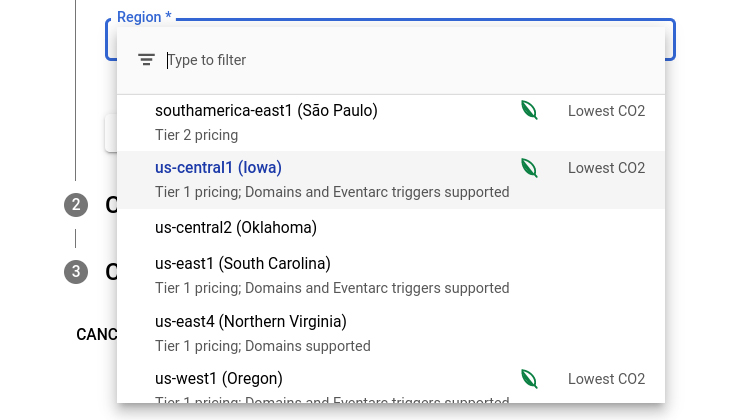Google Cloud customers can now select regions based on CO2 output
The update is part of Google’s company-wide sustainability initiative that aims to achieve carbon-free status by 2030


Google Cloud has announced an update to its data centre region picker that allows customers to reduce their carbon footprint by choosing a region based on its CO2 output.
Starting today, Cloud Run and Datastream users will be able to find a region with the lowest carbon impact inside the Cloud Console location selectors, with the tool being rolled out to other Google Cloud offerings over time.
Regions will receive labels such as "Lowest CO2" or a leaf symbol, which means that the region has a carbon-free energy percentage of at least 75% or, in case this information is not available yet, a grid carbon intensity of no higher than 200 gCO2eq/kWh.

Grid carbon intensity is estimated based on average lifecycle gross emissions per unit of energy and is used to compare the regions in terms of carbon intensity. For instance, although Frankfurt and the Netherlands have similar CFE scores, the Netherlands has a higher emissions factor.
The update is part of Google’s company-wide sustainability initiative which aims to achieve carbon-free status by 2030. The tech giant has been carbon-neutral since 2007.
RELATED RESOURCE

Cloud operational excellence
Everything you need to know about optimising your cloud operations
Besides the region picker’s Carbon footprint indicator, which was first previewed earlier this year and works by measuring the amount of carbon-free energy supply for each region, users can also filter regions based on cost as well as latency. The latter is estimated based on the physical distance between the customer’s headquarters and the city or country of the data storage region.
Commenting on the announcement, Carbon-free for Google Cloud Platform (GCP) product manager Steren Giannini said the tech giant wanted to empower its customers “to make more sustainable decisions and progress with us towards this 24/7 carbon-free future”.
Get the ITPro daily newsletter
Sign up today and you will receive a free copy of our Future Focus 2025 report - the leading guidance on AI, cybersecurity and other IT challenges as per 700+ senior executives
“Earlier this year, we published the carbon characteristics of our Google Cloud regions. Later, we introduced a simple tool to help you pick a Google Cloud region, taking variables like price, latency and sustainability into account. Our next question was: what’s the best way to surface that sustainability info when you’re actually picking a region for your cloud resources?” he added.
“By sharing and displaying carbon information of Google Cloud regions, together we’re making tangible progress towards our goal of a carbon-free future.”
Having only graduated from City University in 2019, Sabina has already demonstrated her abilities as a keen writer and effective journalist. Currently a content writer for Drapers, Sabina spent a number of years writing for ITPro, specialising in networking and telecommunications, as well as charting the efforts of technology companies to improve their inclusion and diversity strategies, a topic close to her heart.
Sabina has also held a number of editorial roles at Harper's Bazaar, Cube Collective, and HighClouds.
-
 Bigger salaries, more burnout: Is the CISO role in crisis?
Bigger salaries, more burnout: Is the CISO role in crisis?In-depth CISOs are more stressed than ever before – but why is this and what can be done?
By Kate O'Flaherty Published
-
 Cheap cyber crime kits can be bought on the dark web for less than $25
Cheap cyber crime kits can be bought on the dark web for less than $25News Research from NordVPN shows phishing kits are now widely available on the dark web and via messaging apps like Telegram, and are often selling for less than $25.
By Emma Woollacott Published